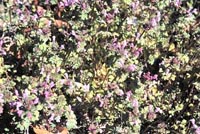Resource Library
Plant of the Week: Henbit
The University of Arkansas System Division of Agriculture does not promote, support or recommend plants featured in "Plant of the Week." Please consult your local Extension office for plants suitable for your region.
Plant of the Week
Henbit
Latin: Lamium amplexcaule

One of my mother's favorite refrains has always been "you're known by the company you keep." A similar old saw, but one mom never mentioned as I was growing up, is, "You don’t get to choose your relatives." These two truisms come together in the Lamiums. Some are excellent plants for the perennial border, while others are pernicious weeds.
Henbit is one of the most common lawn weeds, and it also invades disturbed sites in the vegetable garden and flower border. Its purple, two-lipped tubular flowers are one of the first things to show color in early spring. Many of these early flowers never open completely, and the plant goes merrily about the business of producing seeds by self-pollinating itself undeterred by the weather.
Henbit usually grows 6 inches tall and a foot or more across with purple flowers at the ends of the stems in small whorls. The plant usually has only a single point of attachment, but stem rooting occurs later in the spring, making hand removal more difficult.
The opposite, much-notched leaves are about the size of a nickel and tightly clasp the square stems. Lower leaves are long-petioled and have little resemblance to the upper leaves. Leaf pairs alternate at right angles as they ascend the stem.
Henbit is in the mint family and grows as a winter annual in Arkansas. It originated in Eurasia and has now become established as a weed in almost all areas of the US except for a small part of the inner-mountain west.
The ornamental Lamiums go under the common name of Spotted Dead Nettles because the leaves are usually blotched with silver and they somewhat resemble the wild nettles. Among the ornamentals is L. maculatum 'Beacon Silver,' which is used as a groundcover in shaded sites. Most of the Beacon Silver leaf is marked with a broad silver blotch. The pinkish-purple flowers are larger and more showy than its weedy cousin and appear in early spring.
Henbit seldom survives our summer heat, so it's mostly seen from February through June. By that time, if left to its own devices, it will brood a large amount of seed for germination the following fall. Henbit seeds germinate in September as soon as the fall rains begin and the nights begin to cool off.
Prevention is the easiest approach to controlling henbit. All of the fall-applied pre-emergence herbicides do a good job of controlling henbit if they’re applied before the seeds germinate. If this control opportunity is missed, they can be controlled by post-emergence compounds such as Trimec.
The weed is easier to control in early spring while the plants are small. Also, given henbit's ability to produce large amounts of seeds as even a relatively small plant, control should be initiated early.
For garden beds and borders, henbit is easy to prevent by mulching. A 3-inch thick layer of clean organic mulch will effectively prevent germination. The few plants that do appear can be easily handled by hand weeding.
By: Gerald Klingaman, retired
Extension Horticulturist - Ornamentals
Extension News - April 13, 2001
The University of Arkansas System Division of Agriculture does not maintain lists of retail outlets where these plants can be purchased. Please check your local nursery or other retail outlets to ask about the availability of these plants for your growing area.